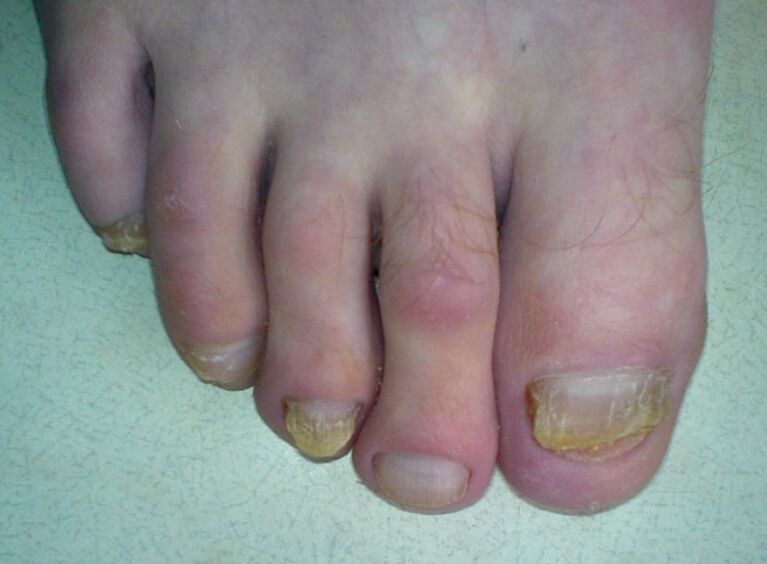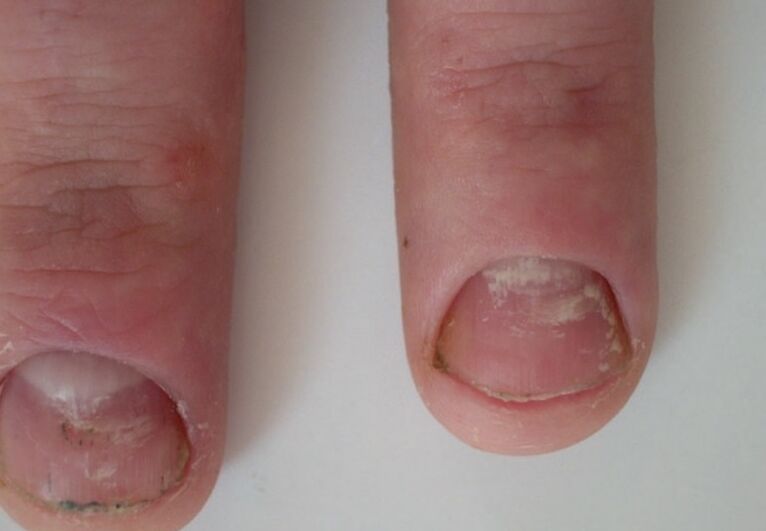Onychomycosis of the feet and hands is characterized by multiple symptoms. The appearance of nail fungus depends on the type of pathogen (there are approximately 50 species in total), the location of the primary infection, and the accompanying disease. There are several most common types of onychomycosis, each with its own characteristics. The initial stage of pathological identification only allows treatment with the help of local funds. Otherwise, you will need to take systemic antifungal drugs. With the advanced form of the disease and complete damage, repair of the nail plate becomes impossible.
Onychomycosis: a short description
Onychomycosis is a fungal infection of the nail plate of the legs (80% of cases) or hands. The elderly (40% of those over 60 are sick) and people with the following diseases are at risk:
- psoriasis;
- Diabetes (prevalence is three times that of other populations) and other endocrine diseases;
- The blood supply to the limbs is destroyed due to cardiovascular disease, and the vascular process disappears, leading to narrowing of the blood vessels; vascular neurotrophic disease, varicose veins;
- Tumor disease
- Hemorrhagic sarcoma (a variety of skin cancers);
- Skin diseases associated with violations of the cytokeratinization process, ichthyosis;
- Broken bones in the hands or feet;
- Other serious physical diseases lead to general exhaustion and decline in body defense capabilities.
The following professions belong to the occupational risk group:
- miner;
- athlete;
- Employees of public institutions;
- Metallurgist
- Military personnel;
- Medical workers;
- Industrial worker
- Cooks and other workers whose activities are related to frequent contact with water.
Among all nail diseases, the prevalence of onychomycosis ranks third, and the total number of carriers of the disease accounts for one-fifth of the world's population. The danger of this disease is that the focus of fungal infections can persist for a long time and become an active source of infection for other people, including your own family.
In addition, the fungus produces toxins and causes general body allergies, which can lead to allergies and skin diseases in patients. Therefore, it is important to identify the fungus at the initial stage and stop its growth, spreading through lymph and blood. Infection occurs in the following ways:
- In public places, such as bathrooms, saunas, swimming pools, gyms;
- By sharing household items (carpets, towels, towels);
- During nail manicure;
- When wearing other people's shoes.
There are also risk factors:
- Wear tight shoes;
- Humid and hot climate;
- Increased sweating in the legs;
- Weakened immunity;
- Taking hormones and antibacterial drugs;
- Damage to the nail plate and changes in malnutrition.
Type of disease
There are many types of onychomycosis, which can be classified according to various criteria. These characteristics help determine what nail fungus looks like on hands and feet.
According to the type of pathogen. In 3/4 of all cases, the nail plate was destroyed by a pathogen, including 2 cases-16% and three cases-9%. The most common mixed infections occur in elderly patients. The most common pathogens are:
- Dermatophytes, the most common are Trichophyton rubrum (80% of all cases) and tinea tinea var. Interdigitale (about 10% of cases). Epidermophyton flocculus, Trichophyton violaceum and T. tonsurans are less common (3% of the total number of cases).
- The yeast fungus of the genus Candida affects the nail plates on the hands (in 40% of the cases) more than the nail plates on the legs. The disease is usually accompanied by chronic candidiasis of the skin and mucous membranes. Several species of Candida exist as symbionts on the skin of healthy people.
- Non-dermatophyte molds-Scytalidium dimidiatum and hyalinum, Onychocola canadensis. It is most common in countries with warm and humid climates.
According to the shape of the nail plate lesion. In the same patient, the types of injuries can be combined. According to the changes of nails, the following forms can be distinguished:
- Positive nutrition-only color change (yellow at the distal, free edge). The normal shape and thickness of the plate can be maintained for a long time. At the edges, the keratinocytes under the nails divide too fast and thicken.
- Hypertrophy-In addition to yellowing and dullness, thickening and deformation of the nail plate is also observed. Over time, they will appear horizontal streaks, the color will turn gray, and the distal edges will become loose.
- Atrophy-severe damage to the nails, and the skin under the nails is exposed and covered with fragile, fragile bumps.
- Depending on the type of nail dissolution-the nail plate becomes thinner and separates from the nail bed. The color is dull, dirty gray or yellowish; in the root zone, the color may remain the same.
Damage location:
- Distal lateral onychomycosis.
- The surface is white. When scratched, their surface properties can be determined.
- Under the proximal armour.
- Completely malnourished.
The first is the most common, the source of the lesion is infected skin. The beginning of the process takes place in the distal part-the free edge towards the root, which is why the breed gets its name. In the initial stage, the nail plate maintains its normal appearance, but then gradually separates from the bed and turns yellow. In some cases, thickening was observed. In the final stage, depending on the degree of bacterial contamination, the color of the nails will show different shades (from green, blue to brown).

The second form of onychomycosis is characterized by the appearance of white spots, streaks that appear on the outer surface of the nail, and gradually spread to the entire plate. Over time, the spots will turn yellow or tan. In most cases, this pathology is related to the seeding of Trichophyton mentagrophytes or Aspergillus molds. This disease is more common in the elderly. Normally, the base of the nail and the bed remain intact, while the plate will chip and turn gray or brown.

Subungual lesions are the rarest form. The pathogen can be all three types of pathogens. The infection spreads from the skin or lateral ridges to the roots of the nails. The stain appears on the central part or hole of the nail plate, and then comes off soon. The nail bed and root are not inflamed, but there are often secondary bacterial infections that cause the nails to turn black.

With the general form of the disease, the entire area of the nail is affected, in many cases with its complete destruction. The root pathologically disappears or thickens, so it is no longer possible to form a plate normally. In the final stage of the disease, only its broken remains can be observed. This form of onychomycosis is usually associated with candidiasis. The pathogen can also be an epidermal fungus.

First signs of illness
Some symptoms help identify fungal infections in the initial stages. The patient may have one or more of the following:
- The nail plate loses its transparency and luster;
- The nail color turns white or yellow;
- The edge of the nail becomes uneven, thinner, and soft;
- Yellow or white spots, streaks appear along the edge of the plate (on the hand-in the center of the nail plate);
- Certain types of fungi only damage the nails on the first toe, and the rest remain the same (these include superficial white onychomycosis, which usually damages the nails of the first toe, and less commonly the small toes);
- The board moves 1-2 mm from the bed.
For a long time, the pathological process can only be located along the far edge of the steel plate, so the infection can be prevented by preventing the nail plate from deforming, falling off, and root damage, resulting in irreversible consequences.
As the process progresses, other signs will appear:
- There are white stripes from the free edge to the root;
- The "ribbing" of the nail in the horizontal direction;
- Its thinning
- Cracked steel plate and other symptoms corresponding to certain onychomycosis.
There is almost no white superficial onychomycosis on the fingernails. Sometimes this form of disease is combined with distant disease. When infected with Т. rubrum, the damage is usually multiple. When infected with a Candida fungus (and in a more rare case, a fungal infection), inflammation of the posterior or lateral nail ridge occurs first, accompanied by the following symptoms:
- Redness, compaction and swelling of the roller;
- Change its shape;
- White scales appear along the edge of the drum;
- The separation and destruction of the stratum corneum;
- Pain on palpation of the lesion;
- In rare cases, a small amount of pus will be released when pressed.
In children, the initial stage of the disease has the following characteristics:
- Rough nail surface;
- The form is often unchanged;
- Failure in most cases-on the distal edge;
- Active fungal processes were also observed on the skin of the feet;
- In more rare cases, subungual hyperkeratosis will be detected.
If the nail is bright green, it means that a secondary bacterial infection-Pseudomonas aeruginosa has been increased, and black indicates that it is infected with Proteus.
Difference from other pathologies
Changes in nails are also observed in other diseases, similar to changes in onychomycosis:
- Psoriasis (nail peeling off along the edge, thickening, uneven surface "thimble", peeling off along the ridge, yellowing, nail damage);
- Lichen planus (the center of the steel plate is deeply cracked, longitudinally thickened, subungual hyperkeratosis, falling off along the distal edge, increased fragility, and nail loss due to splitting);
- Eczema (lateral grooves, tissue softening, peeling along the edges, thickening of the rollers);
- Trichophytonosis (in this case, there are also smooth or hairy skin lesions).
Because the external symptoms of onychomycosis may occur at the same time as non-fungal diseases, microscopic examination and pathogen seeding are required to make an accurate diagnosis.
treatment
In the initial stage of the disease, if no more than half of the nail plate is affected, it can be treated with only local therapy. The treatment strategy also depends on the form of the disease.
Long-term multiple onychomycosis with bacterial complications must be treated for a longer period of time with the help of systemic antifungal drugs-several months. Local treatment is performed when the risk of side effects is high, pregnant and lactating women, patients with liver disease, kidney disease, and drug allergies. The disadvantage of topical drugs is that they cannot penetrate the root of the nail. If the matrix is damaged, this treatment is ineffective.
Before using an antifungal agent, a pretreatment is required-removing the infected area. This is done with the help of keratolytic agents: ointments, patches. Treatment takes place within 1-3 weeks. After cleaning, apply one of the antifungal drugs in the following forms:
- cream;
- solution;
- paint.
Apply cream and solution twice a day until healthy nails grow back. As a precaution, it is recommended to treat unaffected nails. Use varnish 1-2 times a week for at least six months. They can be used as the only medicine for treatment only when no more than one-third of the nail plates are affected and the disease lasts no more than 1 year.
If a fungal infection of the toenail occurs, the shoes need to be disinfected with a 40% formalin solution. After wiping with a wet cotton swab, leave it in the shoe and wrap it in a plastic bag overnight. Since formalin is toxic, shoes and rooms must be ventilated after disinfection. The patient's socks must be boiled.
As a precaution, the following recommendations must be observed:
- Take measures to eliminate excessive sweating in the legs (use powder, use urotropine-based preparations for treatment).
- Please use a separate rubber sheet when visiting swimming pools, beaches and similar places.
- Change socks every day and disinfect shoes regularly.
- Treat other nail diseases promptly and moisturize dry hands and feet skin.
- Only use your own shoes.















